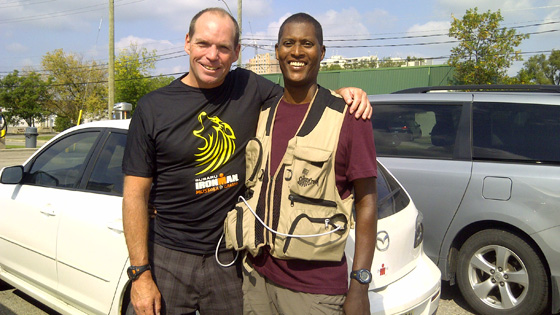
Mike Walker (left), Exercise Physiologist, Peter Munk Cardiac Centre, met Charles Cook (right), near his home in Kitchener, ON., one week after Mike successfully participated in an Ironman event. Mike wanted to thank Charles personally for inspiring him to take part in the event. (Photo: PMCC)
Charles Cook was 17 years old in the United States Naval Academy when he was diagnosed with a genetic heart condition called hypertrophic cardiomyopathy (HCM), caused by an enlarged heart muscle.
He received a medical discharge and while at university, he came to the conclusion that every new day gives the opportunity to "keep bangin'" through the obstacles life throws at you.
That philosophy kept him afloat and inspired others – including at least one UHN caregiver - in the years to come, during which he would suffer a stroke, cardiac arrest, and ultimately heart failure.
Related to this story:
The power of persistence
In 2005, Charles suffered a massive stroke, keeping him off his feet for over a year. Soon after, a defibrillator implanted in his chest saved his life after cardiac arrest.
"The thing that has gotten me through any of the challenges that I have faced in my life is a strong belief that patience and persistence can overcome just about any obstacle," Charles explains.
"If an obstacle is placed in front of me I just keep bangin' until I knock it down and then I move onto the next one - and there is always a next one."
After suffering heart failure soon after immigrating to Canada in 2009, Charles was referred to Dr. Heather Ross, cardiologist at the Peter Munk Cardiac Centre, and her team in the Heart Function Clinic.
The team includes exercise physiologist, Mike Walker, who regularly conducted cardiopulmonary exercise tests on Charles.
Over the years the pair developed a mutual respect for each other and a friendship --- all of which made one day in January 2015 particularly difficult for both men.
One hundred days at Toronto General
Mike had completed a series of tests on Charles that January day, and the news was discouraging.
Charles was admitted to the hospital immediately. He would spend the next 100 days at Toronto General Hospital.
Over a three-and-a-half-month span, Cook underwent surgery to have a left ventricular assist device (LVAD) implanted in his chest to help keep his heart pumping.
An LVAD pumps blood from the heart's left ventricle to the rest of the body. The device is surgically implanted under the skin, with a battery pack and control unit worn externally.
Then, complications arose when Charles suffered kidney failure – he required dialysis.
After being discharged from the Peter Munk Cardiac Centre on April 24, Charles had to be re-admitted and had surgery to replace the LVAD due to a clotting in the original one.
Ironman down
During one of his LVAD clinic appointments in June, Charles and his exercise physiologist, Mike, reconnected.
Mike shared that he had been hit by a car while cycling which had left him unable to train for the Ironman race in Muskoka on Aug. 30. He required knee surgery and told Charles that he was going to withdraw from the race.
During that exchange, Charles shared his philosophy, telling Mike that when you face an obstacle in life, you "just keep bangin'" until you knock it down and get ready for the next one.
"After hearing everything that Charles had been through, the concept of a 3.8 km swim, 180 km bike ride, and 42 km run didn't seem that difficult," says Mike.
So, he kept his race registration.
Rise to the challenge
Dr. Phyllis Billia, cardiologist, Peter Munk Cardiac Centre, had been monitoring Charles in the LVAD clinic. She told him in July that he needed to increase his stamina in order to be placed on the heart transplant list.
Hearing this, Mike challenged Charles to complete a 42-minute continuous walk by the end of August – one minute of walking for Charles for every kilometre Mike aimed to run during the final portion of the Ironman race.
On Sunday, Aug. 30, both men completed their goals.
"It would have been easy to quit the Ironman race and no one would really care, but I had Charles in my head all day and that voice to 'just keep bangin,'" Mike admits.
"I knew that he had completed his challenge walk and there was no way I was going to let him down. Everyone was complaining about how tough the course was and I was just thinking how tough every day is for Charles," he says.
In addition to the impact that Charles had on him, Mike is also grateful to Dr. Darrell Olgivie-Harris, orthopedic surgeon at Toronto Western Hospital.
"Dr. Ogilvie-Harris was key in helping me get to the start line, and Charles Cook instrumental in getting me to the finish line," Mike explains.
The real Ironman
It came as a surprise to Charles when Mike told him how much his story had inspired him.
"I have only ever tried to inspire two people and they are my son and daughter. I have tried to be open and honest with them about my wins as well as losses in life," Charles explains.
"My hope is that they know that as long as you can get up one more time when you get knocked down by life, you will be fine."
At the finish line of the Ironman race, the announcer says the participants' names and tells them, 'You are an Ironman.'
For Mike, the true Ironman is Charles Cook, who is currently an outpatient in the LVAD clinic at the Peter Munk Cardiac Centre, awaiting both a heart and kidney transplant.
Special thanks to everyone who helped Mike Walker raise funds for the Heart Function Clinic at www.inaheartbeat.ca/ironman as part of Dr. Heather Ross' Test Your Limits campaign.
